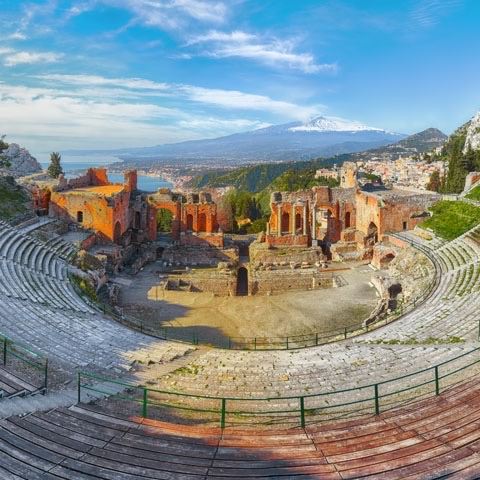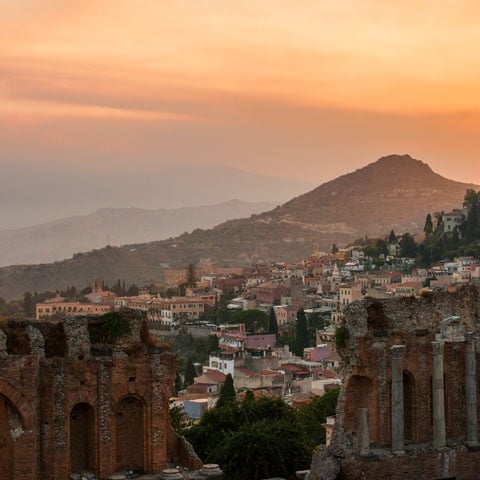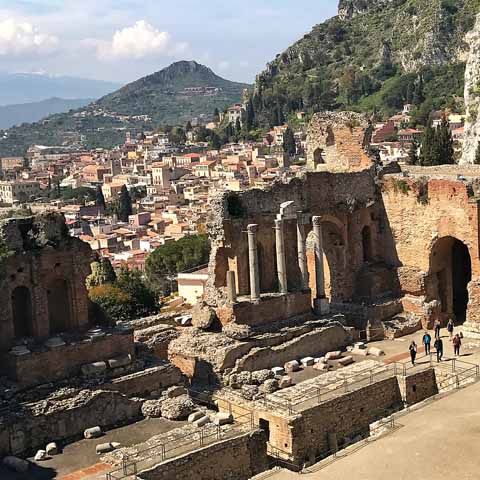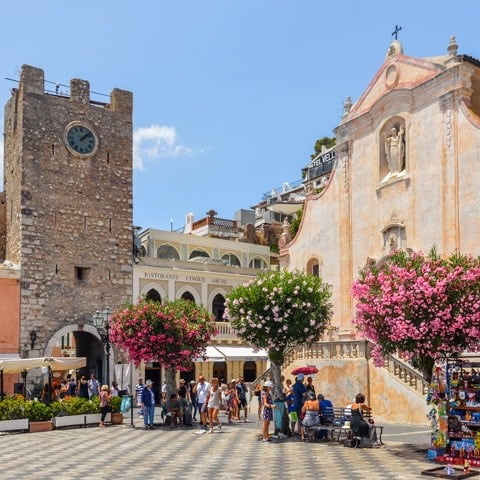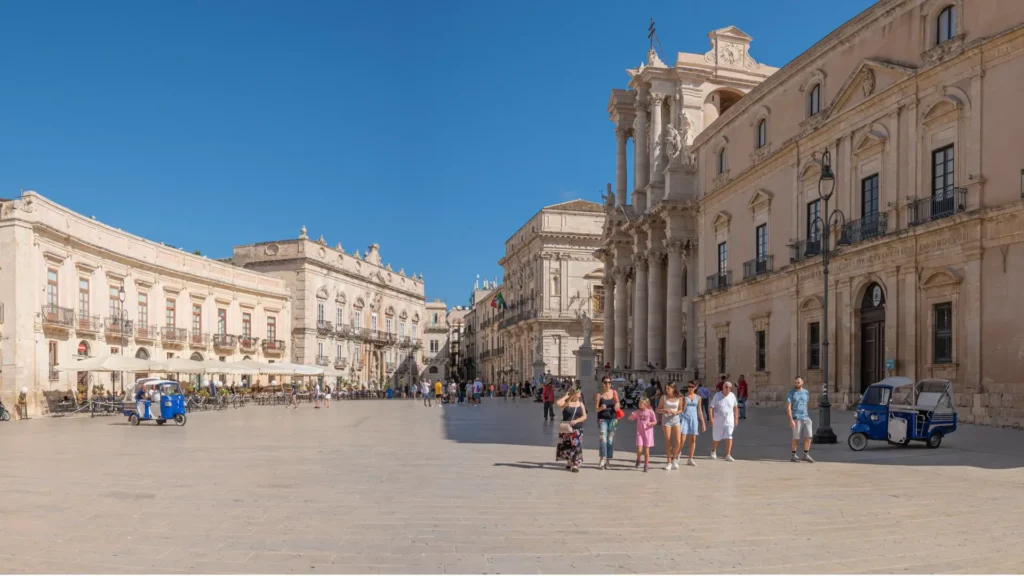Taormina is a small Italian town located in the metropolitan area of Messina, in Sicily. It is one of the most important international tourist centers in the Sicilian region, known for its natural landscapes, marine beauty, and historical monuments.
All of these factors have made Taormina one of the most important travel destinations in Italy and Europe since the nineteenth century.
During the twentieth century, Taormina became a colony of expatriate writers, intellectuals, and artists. Some of the names that spent some of their lives here include Albert Stopford and D.H. Lawrence.
Like most of Sicily, the territory of the town was inhabited since the earliest times, and the entire region enjoys a rich history.
PREHISTORY OF TAORMINA
The existence of Taormina was attested for the first time by Diodorus of Sicily, in the fourteenth book of this Bibliotheca Historica.
According to his writings, the first people living in Taormina were involved in agriculture and breeding of livestock, long before the arrival of the Greeks in 735 BC. When the Greeks finally arrived, they established themselves near the mouth of the Alcantara River and founded Naxos, the first Greek colony in Sicily.
Dionysius of Syracuse, of Doric origins and an ally of Sparta in the war against Athens, briefly tolerated the presence of some allies of Athens in Naxos, but quickly moved against them. As a result, the Calcidesi occupied the territory located downstream of Monte Tauro, where the first Sicilian populations were already living together with other Ionian civilizations settled in the area before the establishment of Naxos.
The following centuries saw nothing but struggles between the Greeks and Carthaginians; from these struggles, Taormina was born after the slaughter of Naxos in 403 BC. The Greek survivors gathered and settled on the slopes of a nearby hill, allegedly shaped like a bull. The nascent inhabited center took the name of Tauromenion, a toponym composed of the word Tauro, meaning bull, and menein, which means to remain. Other scholars do not fully agree with this origin, claiming that the actual Naxos transformed into Taormina.
According to the testimony of Diodorus, Taormina, wisely governed by Andromachus, progressed into shining opulence and power. In 345 BC, Timoleon from Corinth disembarked on the shores of Sicily and reached Tauromenium in search of military support in its attempt to back the freedom of Syracuse.
But things took a turn for the worse and Taormina found itself under the dominion of the tyrant of Syracuse, Agathocles. The tyrant ordered the massacre of many illustrious men of the city and sent countless others into exile.
This grim period lasted until the arrival of the Romans in 212 BC. Under the new rule, the entire island was declared a Roman province, and its inhabitants became allies of Rome. Cicero, in the second oration against Verre, mentions Taormina as one of the three Civitates foederati.
During the servile war between 134 and 132 BC, Taormina was occupied by insurgent slaves, and in 36 BC, the Roman emperor Octavian gained control over the territory. In an attempt to repopulate the area, he sent a colony of faithful Romans to settle in Taormina and expelled all inhabitants who were against him. Rome, however, never considered Taormina as important as other neighboring cities, such as Messina or Catania.
HISTORY OF TAORMINA
With the advent of Christianity, Bishop Pancrazio arrived in Taormina and built the first church on the eastern slopes of the town, dedicating it to the saints Peter and Paul. This event resulted in the appointment of the first bishopric seat in Sicily, ending Muslim rule.
However, there is scarce historical evidence of the town from this period, including the fall of the Western Roman Empire, the invasion of the Goths, and the presence of Byzantines in the territory.
Despite the lack of evidence, though, it is certain that Taormina occupied an important strategic position for the military estate of the surrounding areas, as it constituted the last trip of the Eastern Roman Empire for over 60 years, resisting the assaults of the Saracens up to 906 AD.
Towards the end of 906, after a long siege that lasted for two years due to the betrayal of a mercenary from Messina, Taormina was conquered by the Saracens and razed to the ground.
According to the medieval chronicles, all male inhabitants, including the bishop, would have been beheaded.
Perhaps things did not go quite as reported by these exaggerated chronicles, but the massacre counted many victims, including women and children, and was aggravated by the cruel nature of Ibrāhīm II, the Saracen leader.
However, the Saracen invasion could not convert the population to Islam, and in 911, the Christian part of the town regained control over the territory.
As a result, the emir of Palermo, faithful to Ibrāhīm’s dynasty, organized an expedition to regain control of the city in 913; however, the locals resisted the siege strenuously and eventually forced the besieger to give up company.
With the arrival of a new emir in Palermo in 919, Taormina was granted with a truce, which only ended toward the end of the century, when the Arabs finally managed to regain control over the town.
As a result, the most beautiful girls were taken to the Imam, while the others were enslaved. The few survivors fled to the surrounding mountains. A small colony of Greek and Roman Christians remained in the northern part of the territory, while the Saracens extended the settlement towards the south.
For about a century, the Muslims and Christians lived in relative harmony and tolerance. The Muslims also embellished the town with beautiful gardens and fountains.
This peace came to an end in the eleventh century when Great Count Ruggero took possession of the town after he conquered Castronuovo and Val Demone. The Saracens resisted for as long as possible, but surrendered in 1078, while the count constructed over twenty timber fortresses in an attempt to form an insuperable wall.
The town gained some autonomy in the thirteenth century when the bishop’s seat was moved to Taormina. Following the events, Taormina gained the title of State City included in the Diocese of Messina.
As a State City, Taormina followed the history of Sicily under the Swabians and the Aragonese until the seventeenth century. Some noteworthy events during this period include the historic session of the Sicilian Parliament held in Taormina, at Palazzo Corvaja, for the election of the king of Sicily after the death of Martin I the Young.
In the sixteenth century, Philip IV of Spain granted the city with privilege of belonging to the crown permanently.
Towards the end of the seventeenth century, on the occasion of the anti-Spaniard revolt of Messina, Taormina remained faithful to the crown of Spain.
This drew the rage of the French, Messina’s allies, who conquered the town in September 1676. But the French did not consider it an important city, so for a certain period of time it was placed under the military jurisdiction of neighboring Savoca.
Defeated by the French, the town returned under the Spaniards in the eighteenth century, and the viceroy granted it with its ancient privileges.
As Napoleon was advancing towards Naples and the south of Italy, King Ferdinand I of Sicily transferred the seat of the Bourbon Royal Palace to Palermo, thanking Taormina for its ancient loyalty towards the Bourbons and its anti-French feelings.
During this time, the Bourbons engaged themselves in the building of infrastructure, making it easier to access the town, creating the coastal road that connected Messina to Catania passing through Taormina.
The easier access drew the interest of many writers and artists, including Maupassant, Goethe, and Houel, who started to show an interest in this place and its archaeological beauties.
From then on, the town would develop into a true magnet for elitist tourism, initially coming from England. Indeed, Taormina welcomed King Edward VII between 1906 and 1908, while Goethe also mentioned the beauty of this town in his masterpiece Journey to Italy.
The town became famous all over the world for its outstanding natural scenery, views, and colors defined by the snowy, smoky peaks of Etna that drops down into the turquoise sea, but also for its permissive transgression and unbridled dolce vita.
Thanks to its international fame, the events of the first half of the twentieth century did not involve Taormina too much. The town was only slightly affected by the war, although it suffered a devastating bombardment on July 9, 1943, when Allied planes destroyed part of the southern area of the town and a wing of the famous Hotel San Domenico.
In the post-war era, Taormina rose from its ashes, rebuilt itself, and once again became the fascinating destination it once was.
Most of the town’s economy is based on tourism and service sectors, while locals are also involved in fishing and agriculture.
ARCHAEOLOGY IN TAORMINA
Like most cities in Sicily, Taormina preserves rich archaeological evidence, above all from its Greek and Roman history.
One of the most famous outdoor sites is the Greek Theater, an incredibly well-preserved ancient Greek building that is still perfectly functional. During each summer, the theater hosts cinema, theatre, ballet, and classical music events and performances.
Odeon is another theater, but a Roman one. It was built in 21 BC by Caesar Augustus Octavian, the first Roman emperor. Other open-air sites include a Greek agora, Byzantine and Roman baths, and an aqueduct as well as numerous necropolises. The medieval center of the city is also interesting from a historical standpoint.
Indoor sites include the Archaeological Museum of Taormina and the Antiquarium.
The former is housed in a splendid fourteenth-century edifice and houses important collections of artifacts found during excavation works in many of the open-air sites. The most impressive is perhaps the Hellenic collection of jewelry.
The museum also houses a wide collection of majolica ceramics from the seventeenth and eighteenth centuries.
The Antiquarium is housed inside the ancient Greek-Roman theatre. This small archaeological museum occupies two rooms of the edifice and showcases artifacts discovered in the areas of Syracuse, Messina, and Naples.
In this museum, you can also admire some polished stone blocks inscribed with financial statements of the Greek polis; a shred of evidence that Taormina, just like Rome or Athens, kept its political, civil, and financial documents carved in stone.
Travel Guides
The Sicily Region of Italy
The Cities of Sicily, Italy

